Do you want to try BLW with your baby but don’t know how to start? Here’s everything you need to know about baby-led weaning, plus mom’s tips to make it easier.
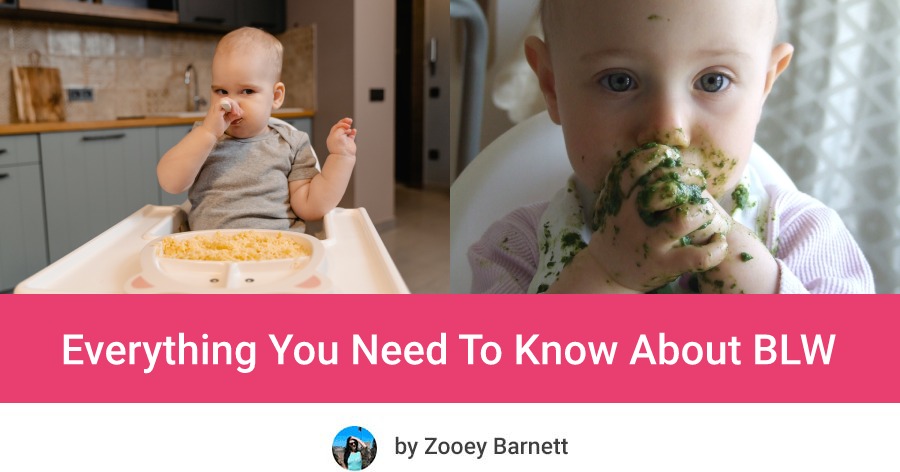
Moms and dads, you may have heard that there is a new style of weaning on the block. You may have also heard that it’s very much in vogue at the moment and that many parents insist that it’s vastly superior to old-school weaning methods.
But is baby-led weaning (BLW) right for your bundle of joy? And what do the studies, experts, and doctors say? What kind of foods are best for infants trying BLW? And last but not least, if I want to try BLW, where do I start? Read on and the answers to all of these questions will be revealed.
This article is NOT a substitute for medical advice.
What Is BLW?
Baby-led weaning (BLW) is an increasingly popular way of introducing your baby to solid food. As the name suggests, it is a way of allowing babies to experiment with self-feeding and to have some choice and control over what food they eat.
It is also an alternative to the more common method of weaning, which involves feeding babies pureed foods that are easier to digest.
Instead of preparing special meals for infants, with baby-led weaning you put a variety of options in front of your kid, without mashing or pureeing any of them, and see which foods your baby chooses.
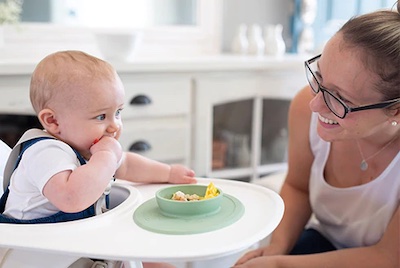
The logic of the baby-led weaning approach has two main aims. The first is to allow your baby to take the lead and discover food at their own pace1. The second is the idea that through your baby self-feeding, they will learn how to handle and chew food at an earlier age.
I used BLW my three babies, and I would recommend the technique. For us family mealtimes as well as cultivating individuality are very important, and we found baby-led weaning to be very helpful in giving our kids the skills they needed to feed themselves individually.
When Can You Start BLW With Baby?
BLW is considered best after your baby turns six months old.
The official line from the WHO is that six months is the earliest you should introduce solids2.
But if for whatever reason you feel you need to start the process earlier (some parents may just be desperate to get a good night’s sleep. I won’t judge), then the more traditional method of weaning may be better.
You could always try to introduce BLW when your baby turns half-a-year old.
While some may choose to wait a little longer than six months to get your baby to a point of developmental readiness, others would argue that the point of BLW is for your baby to explore and learn how to self-feed.
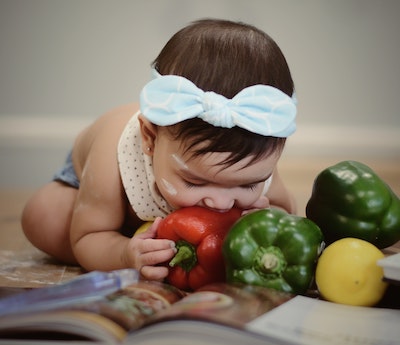
Is My Baby Ready For Weaning?
The signs that your baby is developmentally ready to eat solid foods include:
An Interest In Food
If your baby is eying your food hungrily or reaches out to try to grab and eat some, that’s a good sign that they’re ready to start weaning. Another telltale sign is if they open their mouth when you try to give them a morsel of family food.
Head And Neck Control
If your baby can’t yet hold up their head, it’s too early for them to eat solids.
Doubled In Weight
If your baby is twice as heavy as when they were born, you can start weaning.
How To Start BLW?
So you want to start baby-led weaning? The actual process is pretty easy. The idea is that you can do it during family meal time instead of at a specially designated time, and you can use the same food the rest of the family is eating (with a small twist). There are three basic steps:
Step 1
Bring baby to the table. Babies need to be in an upright position when learning to eat with the family, so a good BLW high chair is a must.
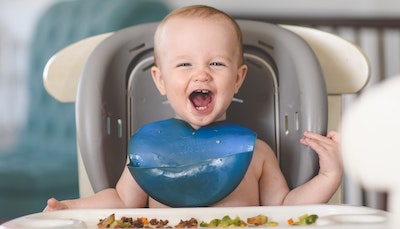
Step 2
Layout some options straight on your highchair tray. Some may want to use a plastic plate but I can assure you, it’s just going to end up on the floor. Silicone suction placemat is a better option.
Give your baby a selection of vegetables, carbs, proteins, and whatever other first foods you think are best to eat. Make sure you follow guidelines on what size pieces you should be offering your baby.
Step 3
Follow your baby’s lead when offering foods when they start solids, whether you go with BLW or the more old-school method. Forcing infants to eat things they don’t want to will only cause trouble later on. With BLW, letting your baby lead the process is a vital part of the philosophy.
| Remember: Too much food to choose will overstimulate your little one. Too little on the other hand could cause your baby to end up as a picky eater. It’s best to start small but pay close attention to see if your baby wants more. |
Some may want to follow a feeding schedule, while others may feel this defeat’s the purpose of BLW’s natural approach, which allows your baby to join family meals and which is based on the theory that your baby is better at knowing what their body needs than we might think.
Useful Tools For Baby Led Weaning
If you’re starting BLW, these gizmos are a must:
High chairs – A high chair is a must, and preferably a good one. To learn how to feed themselves, a baby needs proper support, especially for their trunk and feet muscles. If the larger muscles are supported, the body will be relaxed and your baby will be able to pay attention to the smaller muscles they need to master to self-feed. That’s why you should go for a high chair with adjustable footrest (read my reviews of the best high chairs for baby led weaning)
Bibs for BLW – there’s many a slip between the cup and the lip, as they say. A bib is a must. And if more food seems to end up on that bib than in the mouth at first, that’s normal. Check the best bibs for BLW that I recommend.
A placemat – there’s going to be sweet potato flying everywhere, you might as well try to minimize some of the mess.
Suction silicone bowls – You can place finger foods straight onto the high chair tray, but another great option is using one of those bowls that stick to the tray with suction cups, so your baby can’t take the bowl and chuck it at the wall, even if they want to.
Benefits For BLW Babies
There are plenty of arguments to be made for why parents should try BLW. Here are some of my favorites:
Fine Motor Skills
Learning how to eat and feed themselves is great for your babies’ fine motor skill development, and the sooner you get started, the sooner your little one will gain the ability to self-feed.
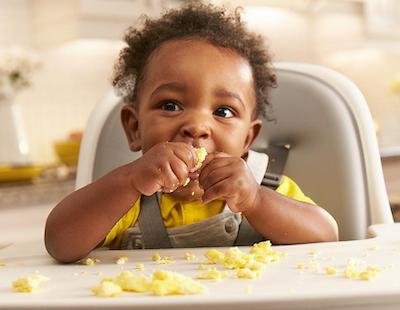
A Feast For The Senses
BLW turns food into a sensory experience, allowing babies to experience their food not just with their sense of taste, but with other senses such as touch, smell, and sight. It introduces them to different textures and a variety of flavors and lets them decide what to put in their mouth.
No Special Meals Or Meal Times
With baby-led weaning, your baby can sample the same foods you’ve cooked for the rest of the family, so you can avoid having to cook and serve food just for your baby.
Babies Can Choose How Much They Eat
While with the traditional method of weaning you would need to guess how much food a hungry baby needs, with baby-led weaning your baby can eat as much as they need.
Better Nutrition
Food does lose some of its nutrients when it is pureed3, so BLW is better at meeting the nutritional needs of infants.
Teaches Your Baby That Food Can Be Fun
BLW makes food fun and so babies are keener to explore it. They don’t see mealtimes as a chore, and so they develop a healthy attitude toward food. For that reason, the theory goes, they will be less likely to end up either as picky eaters or to become obese. They’re also more likely to participate in family meals.
Challenges Of BLW
Of course, BLW isn’t all fun and games. Here are some of the drawbacks…
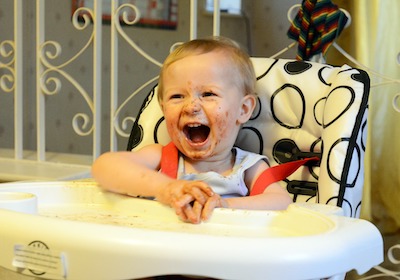
Super-Messy
Let’s face it. There is no way to introduce a baby to solid food that isn’t going to get a bit messy. However, those starting baby-led weaning should be aware that it makes a mess, as unlike with more classical weaning methods, you are not the one holding the spoon, your baby is.
Patience Required
Baby-led weaning is basically watching your baby learn to feed themself, so as you can imagine it demands plenty of patience from parents. You need to be fully present and attentive to your baby’s needs when introducing food they’ve never eaten before.
Choking Risks
Of course, there is also more risk of food becoming a choking hazard. For the sake of safety, babies leading their weaning process need to be watched carefully, and the guidelines on how to prepare food and what size pieces to give your baby to eat must be followed.
Less Control Over Nutrition
Some of BLW’s detractors say that it could cause your baby not to get what they need nutritionally, and for this reason, some try a mixture between BLW and the more traditional style of weaning. Believers in baby-led weaning, meanwhile, argue that babies will naturally choose types and quantities of food that will meet their nutritional needs.
Traditional Weaning / Spoon-Feeding – Benefits & Challenges
The good old-fashioned way of weaning is arguably less complicated than BLW, but there are other advantages too.
There’s the amount of control you have over exactly what ends up in your baby’s mouth. You can make sure your baby gets all the nutrition they need when starting solids, both in terms of how much food they consume and exactly what macronutrients, vitamins and minerals are in it.
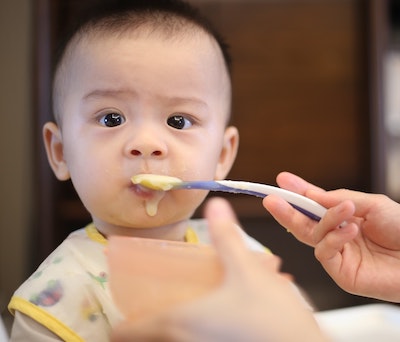
You could argue that BLW gives a baby too much choice when eating solids. With spoon-fed weaning, you could disguise more bitter vegetables in a puree and therefore allow your baby to grow accustomed to more challenging flavors. With BLW, your baby simply has the option of avoiding these foods.
Then there’s the matter of allergens, but this depends on where you stand. Some argue that the traditional way allows you to introduce your baby to food that they could be allergic to more carefully and slowly.
Some advocates of BLW, however, believe that children who are exposed to potential allergens at an early age will be less likely to develop these allergies later. This does appear to be backed up by some evidence4.
There are drawbacks to traditional weaning too. Unlike with BLW, you will need to transition your baby from puree to solids eventually.
You will need to have a special meal time just for baby and sit there spoon-feeding, whereas with BLW your baby sits at the table and feeds themself (but, of course, with plenty of supervision). Another challenge is that some babies simply don’t like being spoon-fed.
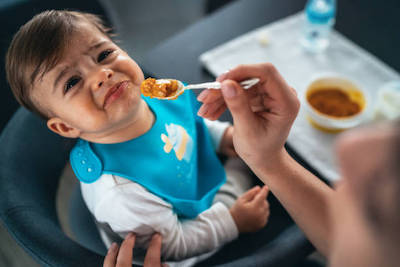
Proponents of BLW would also argue that traditional weaning creates picky eaters and could even lead to obesity. The idea is that self-feeding promotes appetite control.
Best First Foods For Baby Led Weaning
So it’s time to introduce solids and start your baby-led weaning journey. There are a variety of recommended baby-led weaning foods for your baby to choose from.
| IMPORTANT: For babies, iron-rich foods are a must. While breastfed babies get iron from milk, this natural reserve starts depleting at around four to six months old. |
A variety of first foods with a range of different textures is best. These foods can be raw, steamed, boiled, grilled, or fried in a little olive oil. It’s perfectly fine to cook with spices, as long as they are aromatic ones rather than hot ones. There are plenty of healthy recipes online when it comes to introducing new foods for your baby’s weaning journey.
Some recommend exploring baby-led weaning foods that are complementary foods, which are those that complement breast milk5 in terms of nutrition and are designed to provide babies with the energy they need to grow and develop.
Here are some of the most commonly recommended baby-led weaning foods.
| NOTE: These are just suggestions for the best first food and there are plenty of other options. It’s up to you to decide on the best first foods for baby. |
Fruit & Vegetables
- Steamed veggies (e.g. steamed sweet potato, steamed green beans, steamed broccoli, steamed carrots)
- Roasted veg (roasted sweet potato wedges, broccoli florets, butternut squash)
- Avocado
- Roasted fruit (e.g: roasted apple wedges – skin removed)
- Banana strips
- Cooked beans (green beans)
Proteins
- Tender meat and fish (remove small bones)
- Scrambled eggs
- Tofu
Starches
- Oatmeal (can be topped with sliced strawberries)
- Granola bars (crunchy)
- Wheat pasta (cooked until very tender, not al dente)
- Mashed potatoes
What Foods To Avoid During BLW
Before starting baby-led weaning and introducing solid food, it’s important to research not only the best first foods for baby but also what should be avoided.
If you’re trying baby-led weaning, you’ll need to avoid foods that could become choking hazards.
These foods include whole grapes, whole nuts, nut butter, raw apple, cherry tomatoes, and hard-boiled eggs, although these can be safe foods if you prevent choking by cutting them up and ensuring your baby is carefully monitored.
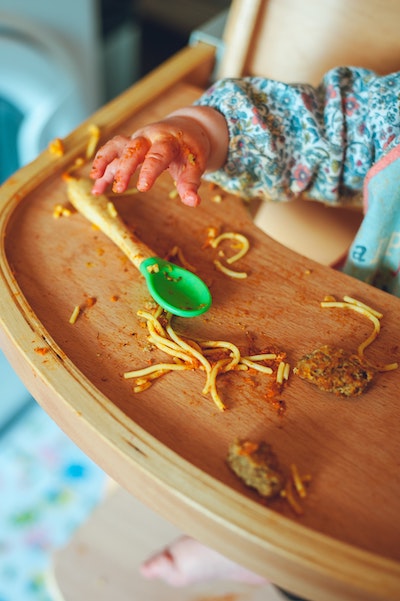
It’s also best to introduce stuff that could cause a food allergy slowly and in a controlled fashion, particularly if there is a history of food allergies in your family.
Although we will touch on a study that suggests that exposure to allergens could actually decrease the chance of your baby developing allergies in later life6.
If this seems like a risky approach, then you should introduce potential allergens only in tiny amounts and carefully monitor your baby’s reaction. A variety of foods could cause allergies, the most common being cow’s milk, peanuts, egg, fish, shellfish, wheat, and soy7.
Less common foods that could cause allergic reactions include peach, banana, avocado, kiwi fruit, Passion fruit, celery, garlic, mustard seeds, aniseed, linseed, sesame seed, and chamomile.
More about first foods and which foods to avoid in baby’s first year in my article: BLW – Foods By Age.
Baby Led Weaning & Choking Hazards
When starting baby-led weaning, the biggest risk is your precious child choking. At this age, your baby’s ability to self-feed will lag behind their enthusiasm.
There is a list of different foods to avoid in the section just before this one – basically anything that has a high choking risk.
Choking vs. Gagging
Your baby has a natural gag reflex at the back of their mouth, which helps protect them by keeping food that has not been chewed enough from blocking their airpipes.
The problem is that gagging, which is usually just a way of stopping food from getting stuck, can resemble choking, which may causes alarm at family meals.
Signs Of Gagging
- Baby coughs and hacks
- Baby’s eyes water
- Baby turns red or purple
Signs Of Choking
- Baby is completely silent
- Baby turns blue
- Baby is unable to cry
If your baby gags, they should recover quickly. If they vomit after gagging, don’t panic: that’s normal.
If your baby is choking, on the other hand, you will need to take action so their air pipes are cleared. Taking a medical aid course and learning CPR before starting solids is recommended8.
While gagging is not a huge problem, it could create a negative association around certain foods, and it could also trigger a reaction among babies with reflux. By offering your baby the right foods and cutting them to the right sizes, you should be able to minimize gagging.
How To Cut Foods For BLW
When cutting foods for baby-led weaning, bigger slices are better, at least at first. Your baby is still learning how to chew foods, so as a general rule, start with pieces of food that are large enough for your baby to grip and are tender enough for easy chewing.
- Small pieces can be introduced when your baby’s pincer grasp develops, before this, a thick slice of meat or a big piece of carrot is best.
- Bite-sized pieces should usually be introduced at around ten months old when your baby has had some practice when it comes to chewing food.
- Slippery foods may present a challenge, in which case there’s a trick – you can grind up cereals into a fine powder and use it as dust to coat any food that most babies find hard to grasp.
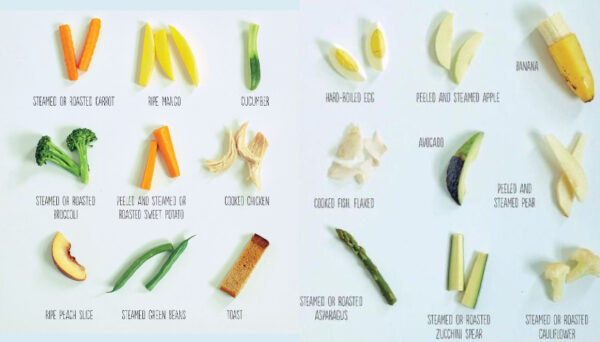
Tips For Keeping Baby Safe While Doing BLW
Some parents worry about the safety of baby-led weaning. While it may seem easier than spoon-feeding, I would argue that BLW is just as hands-on as a method of weaning.
When introducing solids through baby-led weaning, you need to be as present and involved as possible so you can monitor what foods your baby tries as well as how they react to each type of food.
Apart from just being there and being present, you can keep your baby safe during BLW by…
Learning CPR
Even if you’re going with the good old-fashioned type of weaning, your baby could choke. And, as babies make that transition from crawler to toddler, the risk of them finding something dangerous and shoving it into their mouths increases. So, as a parent, learning basic first aid, including CPR for babies and toddlers, is an excellent (and some would say essential) idea.
Getting Educated
Well done, you’re already doing this by reading this blog post! If you know what foods pose a high risk in terms of choking hazards and potential allergens, as well as how to feed your baby, what types of food are best and how to prepare them, there’s way less risk of any problems arising.
Adapting Your Diet
I know what you’re thinking. Isn’t the whole point of BLW for your baby to eat what the rest of the family is eating? Well, to an extent. But you may need to pay some attention to what ingredients you use for a while.
For example, if your family cooks with chillis or other hot spices, you’ll have to leave them out of your diet for a while. It also may be best to go easy on the salt for a while, as babies shouldn’t be having an excess of sodium in their diet.
When we did BLW, we realized that we use sugar in cooking too much and that we weren’t ready to introduce our eldest to sugar yet. So, we cut it out of our diet while weaning.

Talking To An Expert
You should consult with a pediatrician before starting baby-led weaning. Before your baby starts their weaning journey and you start offering solid food, you need to make sure they don’t have a developmental, medical, or motor coordination issue that would make BLW a problem or challenge.
Will My Baby Eat Enough With BLW?
When starting solids, it’s always a bit of a challenge knowing if your baby is getting enough to eat. One possible pitfall of this feeding style is that you don’t get to control how much food goes into your baby’s mouth.
That said, though, when you decide on your baby’s portion sizes, do you know exactly how much they should be eating? Supporters of BLW believe that babies will naturally eat what they need if we give them the opportunity.
Follow your baby’s cues and make sure they are exposed to a variety of foods and a balanced diet including vegetables, protein, and starch.
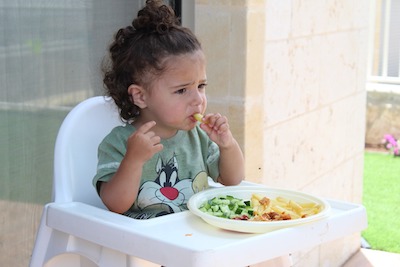
Do Babies Need Teeth For Baby Led Weaning Foods?
For your baby, part of learning to self-feed and trying out new food is learning how to chew it up.
While it seems strange that your baby would be able to chew solids without teeth, your baby’s gums are stronger than you might think.
We actually use the molars right at the back of our mouth to chew our food rather than our front teeth, and since these only appear at around one-and-a-half to two years of age, baby-led weaning usually entails infants chewing things up with their bare gums, which are pretty tough.
Because not all foods can be mashed up with gums alone, you need to start with soft solids. Also, it’s a good idea to stick to the guidelines in this blog post regarding how to cut finger foods and what a baby’s first foods should be.

Can You Mix BLW With Spoon-Feeding?
Not only can you mix baby-led weaning with the more traditional method, but having tried both pure BLW and a combination of baby-led weaning with parent-led weaning and plenty of purees and so-called “baby food”, I’d recommend it.
Mixing old-school weaning with BLW can be the best of both worlds, allowing your baby to experience the textures and flavors of purees as well as more solid foods, which allow them to grab, learn to self-feed and develop their motor skills in the process.
Purees may be a bit easier to adapt to for a baby who is used to breastmilk, but at the same time, baby-led weaning allows your baby to develop important skills when you introduce solids.
Whatever weaning method you choose, when it comes to what your baby eats for their first foods, I believe that offering a variety of foods is very important so your baby can get what they need in terms of nutrition.
When you’re ready to start solid food, you can experiment with the same foods in different forms. For example, when it comes to some soft foods, like sweet potatoes, whether your baby tries this first food as spoon-fed purees or as finger food, they are getting some nutritional value.
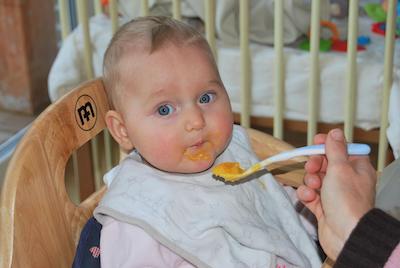
Trying a mix of a baby-led approach and traditional methods when you introduce solid food allows you to experience the benefits while avoiding the drawbacks of both methods in my opinion.
Finger Foods Or Purees?
This may seem like the same question as “BLW or traditional methods?” and to an extent it is.
Finger food is a vital part of the baby-led weaning approach, but nothing is stopping you from mixing and matching a bit when you introduce solid foods.
One major benefit of the baby-led weaning style is your baby eating the same food as the rest of the family, your baby sits with you for family meals and gets to try a wider range of new foods. All of this can be done with a mix of purees and finger foods.
For example, when we did BLW, we still gave our kids a bit of puree for variation. We found that this way, we could introduce stuff we couldn’t with BLW. My firstborn would eat spinach when it was mixed in with a puree, but not as a finger food.
At the end of the day, I would recommend not agonizing too much over whether your baby is eating finger foods or baby food. Don’t get too caught up in what you read is right for your kid and focus instead on your instincts and what you think is right.
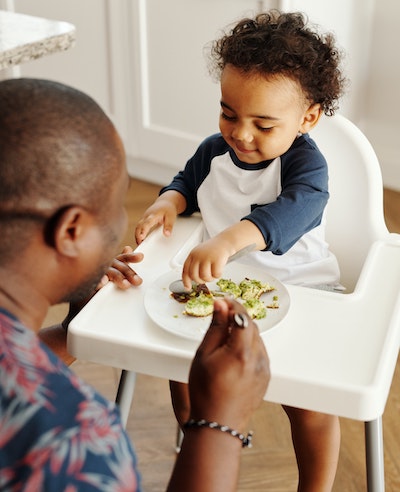
As long as it’s healthy foods going into that mouth, your baby’s first food experiences should be beneficial. If your baby is getting the nutrients they need to grow (and eating plenty of vegetables), you’re good.
Do You Still Breastfeed With Baby Led Weaning?
The simple answer is yes, there is no method of weaning I’ve heard of which involves cutting out breast milk or formula all in one go.
Just as with the more traditional method, you would be starting solid foods for baby-led weaning when you are still feeding your baby breast milk or formula.
You would then slowly reduce the amount of breastmilk and slowly increase the intake of solids, rather than simply expecting your baby to go cold turkey on mama’s milk or that familiar formula. For the first year of your baby’s life, breast milk or formula should be their primary source of nutrition.
Do Doctors Recommend Baby-Led Weaning?
While many doctors have suggested that baby-led weaning can be beneficial, it isn’t officially recommended, as there are not yet enough large-scale studies that prove its superiority over spoon-feeding, or which analyze its potential risks for your baby.
Research shows promising results so far, however, with one study appearing to show that baby-led weaning is good for hand-eye coordination. Another study showed that introducing common allergy-causing foods before your baby is a year old may actually reduce the chance of your baby developing food allergies9.
There also seems to be a lot of anecdotal evidence, with many moms saying that baby-led feeding has helped their baby master their pincer grasp, helped with fine motor skills, and just made meal times fun for them.
While more scientific and medical research is needed, I would predict that it’s only a matter of time before BLW becomes the officially recommended weaning method.
The purpose of this article is informative. It’s not a substitute for professional medical advice or medical care. Remember: safety first! Consult your doctor/pediatrician in case of any doubts. The author of this article does not accept any responsibility for any liability, loss or risk, personal or otherwise, incurred as a consequence, directly or indirectly, from any information or advice contained here.
| Your trust is really important to me: This article includes affiliate links to products that I think are useful for our readers. If you make a purchase through these links, I may earn a small commission at no extra cost to you. Your support helps me run this blog – thank you! |

